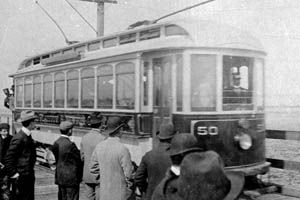
Norman Down
- Builder
- Laconia Car Co.
- Description
- Suburban
- Secondary Use
- Unknown
- Type
- City and Suburban Streetcars
- Year
- 1902
- Retired from Service
- 1927
- Acquired by the Museum
- 1957
- Note
- The necessary Laconia 8B trucks for this car are on hand, but extensive restoration is needed.
- Fund
- 751
Mass. Northeastern St. Ry. 50
From Massachusetts
History
Laconia Car Co. built No. 50 for the Haverhill Plaistow & Newton Railway in 1902. The HP&N merged into the Massachusetts Northeastern Street Railway (commonly called the “Northeastern”) in 1913. The Northeastern continued to operate No. 50 into the 1920s. Massachusetts Northeastern served the region between Newburyport, MA and Nashua, NH and had almost as much track in New Hampshire as it had in Massachusetts. Car 50 ran most of the time between Haverhill, MA and Amesbury, MA via Plaistow, NH and Newton, NH. In the summer, this line extended east of Amesbury to Hampton Beach, NH. The car was an early design popular in New England. When built, it had both transverse and longitudinal seats as it was to be used largely in suburban service where passengers rode longer distances than in the city. Most city cars at the time had all longitudinal seating, but within a few years, the seating configuration found in No. 50 became standard for city cars as well with longitudinal seats only at the ends. The paint scheme for the Northeastern’s cars was chrome yellow with dark red trim. [See also: Trolley Museum Dispatch, January 1973, p. 3]
Eventually, No. 50, as a stripped car body, came to the property of E. Maude Young in Salisbury, MA. In 1957, traction historian and Seashore activist O.R. Cummings purchased the car from Mrs. Young for $50 and donated it to Seashore. This carbody is the sole survivor of the Massachusetts Northeastern.
Technical Information
- Seats: 32
Trucks
- Number: 2
- Manufacturer: Laconia
- Model: 8B
Weight and Dimensions
- Length: 35’ 4.00"
Additional Images

© 1998 - 2025 New England Electric Railway Historical Society. All Rights Reserved.